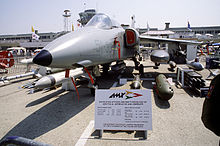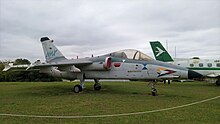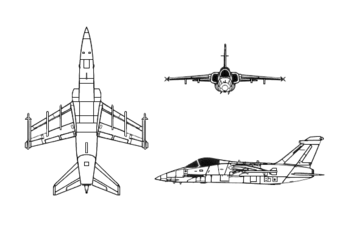AMX International AMX
| AMX | |
|---|---|

| |
| An AMX International of the Italian Air Force | |
| Role | Ground-attack aircraft
|
| National origin | Italy / Brazil |
| Manufacturer | AMX International |
| First flight | 15 May 1984 |
| Introduction | 1989 |
| Retired | Italian Air Force 2024 |
| Status | Active service |
| Primary user | Italian Air Force |
| Produced | 1986–1999 |
| Number built | ~200[citation needed] |
The AMX International AMX is a
During the early 1970s, Italian manufacturer
Development

During early 1977, the
During 1980, the Brazilian government announced that they intended to participate in the program in order to provide a replacement for the Aermacchi MB-326. In July 1981, the Italian and Brazilian governments agreed on joint requirements for the aircraft, and Embraer was invited to join the industrial partnership.[3] An agreement was also struck to divide AMX manufacturing between the partners; for each production aircraft, Aeritalia manufactured 46.5 per cent of the components (central fuselage, stabilisers and rudders), Aermacchi produced 22.8 per cent (front fuselage and tail cone), and Embraer performed 29.7 per cent of the work (wing, air intakes, pylons and drop tanks).[1] There was no duplication of work, each component of the aircraft was built at one source only. The planned requirements were 187 aircraft for Italy and 100 for Brazil.[2]

In the early stages of development, various different powerplants and engine configurations were studied to power the type; both twin-engine and single-engine approaches were considered. The use of US-sourced engines had been promptly discounted to avoid any potential restrictions on export sales of the overall aircraft.[2] Amongst the engines examined were the Turbo-Union RB199 (as used by the larger Panavia Tornado), the Rolls-Royce Turbomeca Adour, Rolls-Royce Viper, and the Rolls-Royce Spey engine.[2] In 1978, the Spey 807 model, which featured several additional improvements, was selected to power the new aircraft.[2]
Key features that were reportedly emphasised in the design process of the new aircraft were accessibility and survivability; the AMX had to be able to sustain a single failure to any onboard system without any performance degradation.[2] To achieve this, key systems are duplicated and vital systems are protected; the use of cockpit armor was considered but ultimately discounted due to the expense involved.[2] The detailed definition phase of the project was completed in March 1980.[1]
A total of seven flight-capable prototypes were produced for the test program, three by Aeritalia, two by Aermacchi, and two by Embraer, as well as two static airframes. The first prototype, assembled in Italy, made its maiden flight on 15 May 1984. This first aircraft was lost on its fifth flight in an accident, resulting in the death of its pilot.[4] Aside from this early loss, testing progressed smoothly and without further incident.[5] The first Brazilian-assembled prototype made its first flight on 16 October 1985. On 11 May 1988, the first production aircraft performed its first flight.[6] Deliveries of production aircraft to Italy began in 1988,[4] the first examples were delivered to the Brazilian Air Force during the following year.[7] On 14 March 1990, the prototype two-seat AMX made its first flight.[6]
Design

The AMX is a conventional shoulder-winged
Drawing on experience from the
A single

Brazilian and Italian aircraft differ considerably in their avionics, Italian aircraft being equipped with various
Various munitions could be mounted on the one centerline and four under-wing hardpoints, including bombs, missiles and rockets; payloads of up to 2,000 lb may be carried upon the centerline and the two innermost under-wing pylons, while the outer pylons can carry up to 1,000 lb.[8] All four of the under-wing hardpoints are plumbed for drop tanks to extend the aircraft's range, Italian aircraft are also fitted with a fixed aerial refueling probe.[11] Optical reconnaissance pods can be carried externally on the centerline hardpoint.[6] Wingtip rails are provided for infrared guided air-to-air missiles such as the AIM-9 Sidewinder and MAA-1 Piranha. Italian aircraft are fitted with a M61 Vulcan 20 mm rotary cannon on the port side of the lower fuselage.[8] The United States denied the sale of the M61 to Brazil, thus its AMXs are instead fitted with two 30 mm DEFA 554 revolver cannons.[9][14]
Operational history

The first operational squadron of the Italian air force, the 103° Gruppo of 51° Stormo formed in November 1989,[15] with the first Italian unit also forming in 1989.[16] Both the Italian and Brazilian AMX fleets were grounded in February 1992, following the crash of an Italian AMX due to engine failure. Operations were allowed to restart in May that year, following modification of the engines.[17][18]
Italy assigned six AMXs from 103° Gruppo to operations over
In the late 1990s, AMX International was considering a major engine refit; a non-

Starting in November 2009, four Italian AMXs were deployed overseas for operations in Afghanistan, replacing the same number of Italian Tornado IDS in the reconnaissance role.[25] Of particular note is the aircraft's ability to share digital electro-optical and infrared sensor information with ground troops in real time, providing valuable reconnaissance information and helping to minimise threat exposure. By the end of 2010 over 700 combat missions had been flown in the Afghan theatre. On 28 May 2014, the AMX performed its last combat sortie in the Afghan theatre, and on 20 June 2014, all remaining AMXs were withdrawn from Afghanistan.[26]
In 2011, Italian AMX aircraft were employed during the
]In March 2012, the Philippines were reportedly holding negotiations with Italy for the possible procurement of used AMX aircraft;[28] however, on 28 March 2014, the Philippines' Department of National Defense signed a contract for 12 FA-50 light attack aircraft worth P18.9 billion (US$421.12 million).[29][30]
Variants

| External images | |
|---|---|
- AMX-T
In 1986, development of a two-seat advanced trainer variant was undertaken. This was intended to provide trainee pilots with experience on fast jets, while still retaining the single-seater's attack capabilities. First flying in 1990, the AMX-T equipped both the Italian and Brazilian air forces.
- AMX-ATA
The AMX Advanced Trainer Attack (AMX-ATA) is a new AMX two-seater multi-mission attack fighter developed for combat roles and advanced training. The AMX-ATA incorporates new sensors, a forward-looking infrared helmet-mounted display, a new multi-mode radar for air-to-air and air-to-surface capability, and new weapons systems including anti-ship missiles and medium-range missiles. The Venezuelan Air Force ordered eight AMX-ATA in 1999 for the advanced trainer and attack aircraft role, but the US Congress vetoed the sale because the aircraft systems include US technology.[31][32]
- AMX-R (RA-1)
An AMX variant designed for reconnaissance missions. Various reconnaissance pallets can be fitted; used by the Brazilian Air Force.
- A-1M
The product of a Brazilian upgrade program of their A-1s; significant features include a Mectron SCP-01 Scipio radar,
- A-11A
Italian military designation for the AMX from 2012.[36]
- TA-11A
Italian military designation for the AMX-T from 2012.[36]
- A-11B
Italian military designation for the AMX ACOL from 2012.[36]
- TA-11B
Italian military designation for the AMX-T ACOL from 2012.[36]
Operators

- Brazilian Air Force operates 51 AMX-As and 8 AMX-T trainers.[37] 43 aircraft modernized to A-1M, delivered between 2013 and 2017, and to be retired in 2032,[38] being replaced by JAS 39E/F Gripen.[39][40]
- 1 Esquadrão/16 Grupo de Aviação Esquadrão Adelphi, Santa Cruz Air Base - disbanded in December 2016 in anticipation of future reactivation with the F-39 Gripen E. Aircraft transferred to Santa Maria Air Base.[41]
- 1 Esquadrão/10 Grupo de Aviação Esquadrão Poker, Santa Maria Air Base
- 3 Esquadrão/10 Grupo de aviação Esquadrão Centauro, Santa Maria Air Base
Aircraft on display

- A retired Italian Air Force AMX is displayed on a pedestal in front of the Thales Alenia Space plant in Turin.[42]
- A retired Italian Air Force AMX (MM7125) is displayed in Vigna di Valle[43]
- Development prototype #5, (Italian Air Force MMX599) is on display at the Milan-Malpensa Airport[44]
- The first prototype built in Brazil is displayed on an open museum called Memorial Aeroespacial Brasileiro in São José dos Campos.[45]
- A decommissioned Brazilian Air Force AMX is displayed at "Praça do Avião" square, which is located close to Galeão International Airport on Governador Island in Rio de Janeiro.[46]
Specifications (AMX)



Data from Jane's All The World's Aircraft 1993–94,[9] Jet Bombers[47]
General characteristics
- Crew: 1
- Length: 13.23 m (43 ft 5 in)
- Wingspan: 8.87 m (29 ft 1 in)
- Height: 4.55 m (14 ft 11 in)
- Wing area: 21 m2 (230 sq ft)
- Empty weight: 6,700 kg (14,771 lb)
- Gross weight: 10,750 kg (23,700 lb)
- Max takeoff weight: 13,000 kg (28,660 lb)
- Fuel capacity: 3,555 L (939 US gal; 782 imp gal) / 2,700 kg (5,952 lb) internal
- 2x 1,000 L (260 US gal; 220 imp gal) drop tanks inboard and 2x 500 L (130 US gal; 110 imp gal) drop tanks outboard[48]
- Powerplant: 1 × Rolls-Royce Spey 807 turbofanengine, 49.1 kN (11,000 lbf) thrust
Performance
- Maximum speed: 1,053 km/h (654 mph, 568 kn) at 10,975 m (36,007 ft)[49]
- Maximum speed: Mach 0.85
- Combat range: 889 km (552 mi, 480 nmi) hi-lo-hi profile, with 900 kg (1,984 lb) of external stores
- Ferry range: 3,336 km (2,073 mi, 1,801 nmi)
- Endurance: 4 hours, 15 minutes[50]
- Service ceiling: 13,000 m (43,000 ft)
- Rate of climb: 52.1 m/s (10,260 ft/min)
- Wing loading: 512 kg/m2 (105 lb/sq ft)
- Thrust/weight: 0.47
Armament
- Guns:
- 1× M61A1 Vulcan 6-barreled Gatling cannon(Italian aircraft)
- 2× 30 mm (1.181 in) Bernardini Mk-164 cannon (Brazilian aircraft)
- 1×
- Rockets: rocket pods
- Missiles: 2× AIM-9 Sidewinders or MAA-1 Piranha or A-Darter,[52] carried on wingtip rails
- air-to-ground missiles
- Bombs: 3,800 kg (8,378 lb) on 5 external hardpoints, including MAR-1[51] missiles, general-purpose and laser-guided bombs
Incidents
- Brazilian A1M lost in April 2019.[53]
See also
Aircraft of comparable role, configuration, and era
Related lists
References
Citations
- ^ a b c d e Gunston and Gilchrist 1993, p. 289.
- ^ a b c d e f g h i Warwick 1981, p. 1544.
- ^ a b Braybrook 1989, p. 267.
- ^ a b Braybrook 1989, p. 275.
- ^ Meitus 1992, pp. 223–224.
- ^ a b c d Gunston and Gilchrist 1993, p. 291.
- ^ Lambert 1993, p. 126.
- ^ a b c d e Warwick 1981, p. 1545.
- ^ a b c Lambert 1993, pp. 129–131.
- ^ Warwick 1981, pp. 1544–1545.
- ^ a b c d e Gunston and Gilchrist 1993, p. 290.
- ^ Braybrook 1989, p. 270.
- ^ Gunston and Gilchrist 1993, pp. 289–290.
- ^ Jackson 1991, p. 135.
- ^ Nicolli 1997, p. 351.
- ^ Jackson 1991, p. 138.
- ^ Nicolli 1997, pp. 351–352.
- ^ "Brazil and Italy lift AMX Ban" Archived 20 December 2013 at the Wayback Machine. Flight International, 6–12 May 1992, p. 14.
- ^ Nicolli 1997, p. 352.
- ^ "Opher bomb deployed in Kosovo". Flight Global.
- ^ Norris, Guy. "EJ200 engine proposed for AMX." Archived 3 October 2013 at the Wayback Machine Flight International, 20 April 1999.
- ^ "Alenia lands $390m AMX upgrade contract". Flight International. Flight Global. 8 February 2005. Archived from the original on 8 September 2007. Retrieved 7 November 2009.
- ^ Niccoli 2009, p.44.
- Jane's, 9 June 2007.
- Jane's, 9 November 2012.
- ^ "Italian Air Force: a year of missions for the AMX airplanes in Afghanistan." Archived 14 July 2014 at the Wayback Machine AvioNews, 3 December 2010.
- ^ Kingston, Tom (14 December 2011). "Italy Gives Bombing Stats for Libya Campaign". Defense News. Archived from the original on 28 July 2012. Retrieved 1 January 2012.
- ^ "DND signs five-year agreement with Italy". The Philippine Star. 8 February 2012. Archived from the original on 6 September 2012. Retrieved 20 February 2012.
- ^ "KAI won a contract to export 12 FA-50s to the Phil". Korea Aerospace Industries, LTD. (KAI). 28 March 2014. Archived from the original on 8 December 2015. Retrieved 29 November 2015.
- ^ "Korean government to sell 12 FA-50 fighter jets to Philippines". Arirang News. 28 March 2014. Archived from the original on 8 December 2015. Retrieved 29 November 2015.
- ^ Spinelli, Andrea. "Venezuela selects MB339FD and AMX ATA combination." Archived 24 June 2016 at the Wayback Machine Flight International, 15 July 1998.
- ^ "Military Aircraft Directory: AMX." Archived 24 June 2016 at the Wayback Machine Flight International, 29 July 1998.
- ^ "Embraer lucra com retrofit de aviões" [Embraer profits from aircraft retrofit], Estadão (in Portuguese), 16 September 2011, archived from the original on 17 September 2011, retrieved 29 January 2012.
- ^ "FLIR Systems wins $7 million contract from Embraer", Military Aero Space, 9 June 2009, archived from the original on 19 December 2013, retrieved 29 January 2012.
- ^ "Elbit consegue contrato de US$187 mi da Embraer" [Elbit gets US$ 187 mi contract with Embraer], Reuters (in Portuguese), 11 November 2009, archived from the original on 20 December 2013, retrieved 29 January 2012.
- ^ a b c d "Utilizzo della Nomenclatura 'Mission Design Series' (MDS) neele Pubblicazioni Tecniche (PPTT) di Competenza della Daa" [Usage of the ‘Mission design series’ (MDS) designation in the technical publications (PTT) under Daa’s competence] (PDF) (in Italian). Ministero Della Defesa. June 2011. Archived (PDF) from the original on 20 December 2013. Retrieved 22 April 2013.
- ^ "World Airliner Census 2011". Archived 25 August 2012 at the Wayback Machine Flight Global, 13–19 December 2011. Retrieved: 10 January 2012
- ^ "FAB ganha poder de fogo com 'novo' caça" (in Portuguese). Archived 29 January 2012 at the Wayback Machine Estadao, 16 January 2012. Retrieved: 16 January 2012.
- ^ "Brazilian air force confirms Gripen acquisition numbers", Flight Global, 18 November 2014, archived from the original on 27 April 2019, retrieved 4 May 2019.
- ^ "Brazilian military could buy over 100 Saab's Gripen multirole combat aircraft". Air recognition. 19 November 2014. Archived from the original on 27 April 2019. Retrieved 4 May 2019.
- ^ "Após desativação do 1º/16º, FAB concentra caças A-1 em Santa Maria". 15 December 2016. Archived from the original on 8 August 2017. Retrieved 8 August 2017.
- ^ "STR. Antica di Collegno, 253 · STR. Antica di Collegno, 253, 10146 Torino TO, Italy".
- ^ "AMX Ghibli". Retrieved 22 November 2019.
- ^ "AMX GHIBLI on Volandia.it". Retrieved 17 March 2021.
- ^ "A história da indústria aeronáutica brasileira no Memorial Aeroespacial Brasileiro". 27 January 2013. Archived from the original on 9 October 2017. Retrieved 1 March 2017.
- ^ "Força Aérea coloca AMX A-1 como monumento na Praça do Avião (RJ)". Retrieved 23 February 2023.
- ^ Gunston and Gilchrist 1993, p. 292.
- ^ "Aeritalia-Embraer-Aermacchi AMX". Archived 5 May 2011 at the Wayback Machine fighter-planes.com. Retrieved: 9 February 2012,
- ^ Donald and Lake 1996, p. 31.
- ^ "Directory: Military Aircraft". Archived 7 March 2016 at the Wayback Machine Flight Global, 21–25 May 2004. Retrieved: 2 February 2012.
- ^ "Defesa ganha mais espaço na Odebrecht" (in Portuguese). Archived 6 June 2013 at the Wayback Machine Estadão, 8 April 2011. Retrieved: 29 January 2012.
- ^ "South Africa, Brazil to Develop A-Darter SRAAM". Archived 4 February 2012 at the Wayback Machine Defense Industry Daily, 26 April 2010. Retrieved: 29 December 2012.
- ^ "Avião da FAB cai em Viamão". DC. Archived from the original on 7 April 2019.
Bibliography
- Air International. "Italy's Black Cats." February 2015, Key Publishing. pp. 64–69.
- Braybrook, Roy. "Assessing the AMX". Air International, June 1989, Vol 36 No 6. Bromley, UK:Fine Scroll. ISSN 0306-5634. pp. 267–278.
- Donald, David and Jon Lake. Encyclopedia of World Military Aircraft. London: Aerospace Publishing, Single Volume Edition, 1996. ISBN 1-874023-95-6.
- Gunston, Bill and Peter Gilchrist. Jet Bombers: From the Messerschmitt Me 262 to the Stealth B-2. Osprey, 1993. ISBN 1-85532-258-7.
- Jackson, Paul. "AMX: The 'Pocket Tornado'". World Air Power Journal. Volume 5, Spring 1991. ISSN 0959-7050. pp. 132–139.
- Lambert, Mark. Jane's All The World's Aircraft 1993–94. Coulsdon, Surry, UK: Jane's Data Division, 1993. ISBN 0-7106-1066-1.
- Metius, Wojtek. "AMX IOC: Service use for Italy's new agile attacker". Air International, October 1992, Vol 43 No 4. Stamford, UK:Key Publishing. ISSN 0306-5634. pp. 222–225.
- Niccoli, Ricardo. "AMX In Italian Service". Air International, June 1997, Vol 52 No 6. Stamford, UK:Key Publishing. ISSN 0306-5634. pp. 349–353.
- Niccoli, Ricardo. "AMX: Upgraded and Ready for Combat". Air International, November 2009, Vol 77 No 5. Stamford, UK:Key Publishing. ISSN 0306-5634. pp. 42–45.
- Warwick, Graham. "AMX design reflects Tornado experience". Flight International, 21 November 1981. pp. 1544–1545.
